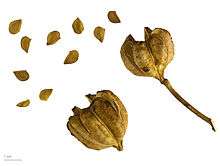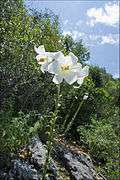Lilium candidum
| Lilium candidum | |
|---|---|
 | |
| Scientific classification | |
| Kingdom: | Plantae |
| (unranked): | Angiosperms |
| (unranked): | Monocots |
| Order: | Liliales |
| Family: | Liliaceae |
| Genus: | Lilium |
| Species: | L. candidum |
| Binomial name | |
| Lilium candidum | |
| Synonyms[1] | |
| |
Lilium candidum, the Madonna lily, is a plant in the true lily family. It is native to the Balkans and Middle East, and naturalized in other parts of Europe, including France, Italy, and Ukraine, and in North Africa, the Canary Islands, Mexico, and other regions.[1][2] It has been cultivated since antiquity, for at least 3,000 years,[3] and has great symbolic value since then for many cultures. It is susceptible to virus diseases of lilies, and especially to Botrytis fungus. One technique to avoid problems with viruses is to grow plants from seed instead of bulblets.
Description
It forms bulbs at ground level, and, unlike other lilies, grows a basal rosette of leaves during winter, which die the following summer. A leafy floral stem, which generally grows 1.2 metres (3 ft 11 in) tall, but exceptionally 2 metres (6 ft 7 in) tall, emerges in late spring and bears several sweetly and very fragrant flowers in summer. The flowers are pure white and tinted yellow in their throats.[4][5][6][7][8]
Taxonomy
In culture

Madonna lilies are depicted in the fresco titled "Prince of the Lilies" in the ruins of the ancient Minoan palace of Knossos.
Some translations of the Bible identify the Hebrew word Shoshannah as "lily" in the Song of Songs: "As the lily among thorns, so is my love among the daughters." (Song of Songs, 2:2 (KJV)) Customarily it is translated as "rose". For example, Abraham ibn Ezra described it as a white flower, which has a good fragrance, and has a six petaled flower and six stamens. But its identity is uncertain, because it typically grows in montane places and not in valleys as the phrase "the lily of the valleys" would have it.
The Bible describes King Solomon's Temple as adorned with designs of Madonna lilies on the columns,[11] and on the brazen Sea (Laver).[12]
The lily symbolizes purity for Roman Catholics. Medieval depictions of the Blessed Virgin Mary, especially at the Annunciation, often show her holding these flowers or show them nearby. Additionally, St. Joseph is frequently depicted with them.
The French adopted the symbol of the fleur de lis, which is can be described as a stylized Madonna lily,[13][14] however the shape of this symbol more accurately resembles that of a flag iris or Iris florentina.[15][16] The lily appears on ancient coins from Yehud Medinata, as well as on medieval banners from Syria in the time of Saladin. The first time it appears in a Western context is in a stone carving decorating the refectory of the Hospitaller compound at Akko, possibly indicating the link to its adoption by the Anjevine royal family of France.
Toxicity

Cats are extremely sensitive to the toxicity of the plant and ingestion is often fatal;[17][18][19] households and gardens which are visited by cats are strongly advised against keeping this plant or placing dried flowers where a cat may brush against them and become dusted with pollen which they then consume while cleaning.[20] Suspected cases require urgent veterinary attention.[21] Rapid treatment with activated charcoal and/or induced vomiting can reduce the amount of toxin absorbed (this is time-sensitive so in some cases vets may advise doing it at home), and large amounts of fluid by IV can reduce damage to kidneys to increase the chances of survival.[21]
Gallery


References
- 1 2 Kew World Checklist of Selected Plant Families
- ↑ Altervista Flora Italiana, Giglio bianco di S. Antonio, Madonna lily, Lilium candidum L.
- ↑ Peter Haggett (Editor) Encyclopedia of World Geography, Volume 15:The Middle East , p. 2089, at Google Books
- ↑ Tutin, T.G. & al. (eds.) (1980). Flora Europaea 5: 1-452. Cambridge University Press.
- ↑ Davis, P.H. (ed.) (1984). Flora of Turkey and the East Aegean Islands, 8: 1-632. Edinburgh University Press, Edinburgh.
- ↑ Danin, A. (2004). Distribution Atlas of Plants in the Flora Palaestina Area, 1-517. The Israel Academy of Sciences and Humanities, Jerusalem.
- ↑ Ikinci, N., Oberprieler, C. & Güner, A. (2006). On the Origin of European Lilies: Phylogenetic Analysis of Lilium Section Liriotypus (Liliaceae) Using Sequences of the Nuclear Ribosomal Transcribed Spacers. Willdenowia 36: 647-565.
- ↑ Dimpoulos, P., Raus, T., Bergmeier, E., Constantinidis, T., Iatrou, G., Kokkini, S., Strid, A., & Tzanoudakis, D. (2013). Vascular Plants of Greece: An Annotated Checklist, 1-372. Botanic Gardens and Botanical Museum Berlin-Dahlem, Berlin and Hellenic Botanical Society, Athens.
- ↑ "BSBI List 2007". Botanical Society of Britain and Ireland. Archived from the original (xls) on 2015-01-25. Retrieved 2014-10-17.
- ↑ "Lilium candidum". Natural Resources Conservation Service PLANTS Database. USDA. Retrieved 24 January 2016.
- ↑ 1 Kings, 7:19.
- ↑ 1 Kings, 7:26.
- ↑ Fongemie, Pauly. "Mary's Symbols". catholictradition.org. Retrieved 6 April 2018.
- ↑ Hans Kurath Middle English Dictionary (1973), p. 1051, at Google Books
- ↑ Stefan Buczacki The Herb Bible: The definitive guide to choosing and growing herbs, p. 223, at Google Books
- ↑ McVicar, Jekka (2006) [1997]. Jekka's Complete Herb Book (Revised ed.). Bookmark Ltd. ISBN 1845093704.
- ↑ Frequently Asked Questions No Lilies For Cats.
- ↑ Fitzgerald, KT (2010). "Lily toxicity in the cat". Top Companion Anim Med. 25: 213–7. doi:10.1053/j.tcam.2010.09.006. PMID 21147474.
- ↑ The trouble with lilies: fabulous but fickle, The Telegraph.
- ↑ The Valentine bouquet that killed my cats: Mother's Day warning on lethal lilies Daily Mail.
- 1 2 Lily Poisoning in Cats. Pet MD.
External links
| Wikispecies has information related to Lilium candidum |
| Wikimedia Commons has media related to Lilium candidum. |